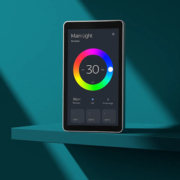How to Choose the Right Home Automation
Home automation has transformed the way we live — making our homes smarter, more efficient, and more secure. But with so many products, platforms, and technologies available, choosing the right system can feel overwhelming. The right choice depends on your needs, budget, and long-term goals.
This guide will walk you through the key factors to consider so you can make a confident decision.
1. Define Your Goals
Before exploring brands or technologies, identify what you want to achieve:
- Convenience: Do you want to control lights, climate, and appliances from a single panel or app?
- Security: Is your priority real-time monitoring, cameras, and smart locks?
- Energy Savings: Are you aiming to reduce electricity bills through automated lighting and HVAC control?
- Comfort & Lifestyle: Would you like preset “scenes” like movie mode or bedtime mode?
Clear goals will help you avoid unnecessary features and focus on what matters most.
2. Understand Your Budget
Home automation systems range from affordable DIY solutions to high-end, fully integrated installations. Consider:
- Entry-Level Systems: Single devices like smart bulbs or plugs (low cost, limited scope).
- Mid-Range Systems: Hubs and panels connecting multiple devices.
- Premium Solutions: Professional installation, custom programming, and full-home integration.
Tip: Start small with scalable products, so you can expand later without replacing the entire system.
3. Choose the Right Control Method
Automation can be managed in different ways:
- Mobile App Control: Flexible, works anywhere with internet access.
- Voice Assistants: Hands-free control with Alexa, Google Assistant, or Siri.
- Central Touch Panels: Wall-mounted hubs for quick, centralized access — ideal for families, offices, and hotels.
For example, Portworld’s Android-based smart touch control panels combine touchscreen, voice control, and multi-protocol support, allowing you to manage all your smart devices in one place.
4. Check Compatibility & Protocol Support
Different devices use different communication protocols:
- Wi-Fi: Common for consumer smart devices.
- Zigbee & Z-Wave: Reliable for lighting, sensors, and security.
- KNX & RS485: Popular in professional-grade building automation.
If you already own smart devices, choose a system that supports them — or opt for a multi-protocol control panel like Portworld’s, which works with KNX, Zigbee, RS485, Modbus, and more.
5. Look for Customization & Scalability
Technology evolves quickly, so your system should adapt to future needs. Consider:
- Can you add more devices later?
- Is the software customizable to match your lifestyle or brand identity?
- Does it support firmware updates for security and new features?
Portworld offers OEM/ODM customization, allowing brands and installers to tailor the interface, functions, and hardware to specific projects.
6. Consider Installation & Support
- DIY Systems: Easy to install but may lack advanced features.
- Professional Installation: Higher cost, but ensures optimal integration, programming, and stability.
- After-Sales Support: Ensure the provider offers technical assistance and software updates.
With Portworld’s centralized smart control panels and multi-protocol support, you can create a seamless, flexible, and future-ready smart home or building — whether for a private residence, smart hotel, or commercial space.



